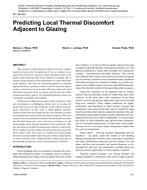Description
The sensations of thermal discomfort in the near-window regions of rooms may be significant. Close to windows occupants may be directly exposed to both transmitted solar irradiation and enhanced long wave radiation exchange due to window surfaces that are noticeably hotter or colder than other room surfaces. The superior insulating qualities of modern high performance glazing systems result in relatively higher surface temperatures in wintertime. This may reduce the local discomfort experienced by occupants and increase the utility of glazed perimeter spaces. In evaluating glazing systems one would like to quantify such benefits.
Prediction of comfort perception in this asymmetric radiant environment is challenging. Being able to account for local, and not just overall, sensations of discomfort is particularly important. In this work a multi-segment dynamic comfort model has been employed that incorporates recently developed models of local thermal comfort response. The work required the development of simulation methods able to predict the detailed long-wave and convective exchanges to the surrounding space and the absorbed solar irradiation. This has been done in an efficient and generic manner so that parametric studies of local comfort responses have been possible. Such studies have been used to examine the relationships between local discomfort and room and window temperatures as well as the role solar irradiation and clothing may play in determining satisfactory winter environmental conditions.
Units: SI
Citation: ASHRAE Transactions, vol. 114, pt. 1, New York 2008
Product Details
- Published:
- 2008
- Number of Pages:
- 11
- File Size:
- 1 file , 3.7 MB
- Product Code(s):
- D-NY-08-053




